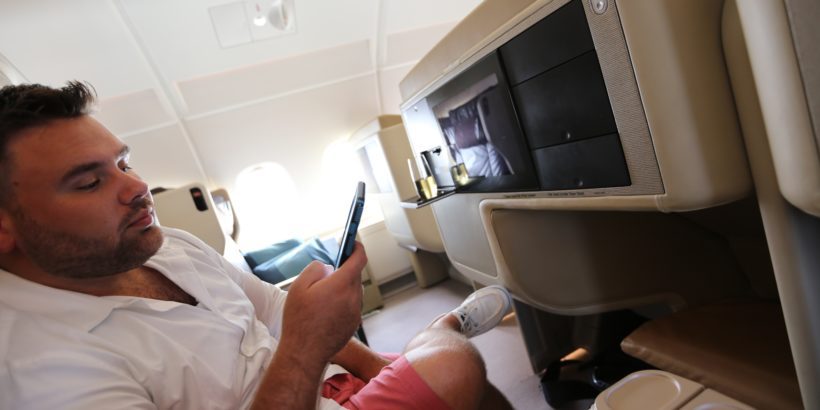One of the most talked about things in award travel is how much the points you’ve earned are worth. It’s usually talked about in terms of cents per point because many banks set point values at one cent per point and it’s one of the easiest ways to figure out different values when running calculations. But are these valuations necessary or helpful? Here’s a look at my take on cents per point valuations and some things to consider.
How to find the cents per point?
Every month The Points Guy publishes/updates his chart with valuations of the points for airlines, hotels, and other award programs. I don’t know anything about their formulas for some of these estimations but generally speaking, a lot of people (including myself) agree with the figures, at least within a couple of tenths of a point. So it’s not a bad thing to review these figures and get a ballpark idea of how much value these points are worth.
Another way to find out is to experiment with dummy bookings that you’d actually take. I prefer this approach because it gives you a real-life example of what your points will be worth for your specific travel goals. Once you do this, you may come to find that the particular routes you want to fly actually have lower redemption values than what the chart says. If that’s the case, then the cents per point value for your preferred travel goals might be a bit lower (more on that below). The converse may also be true.

How to figure out cents per point?
It’s very simple, and I’ll use a real example to illustrate it.
I recently used 10,000 SPG Starpoints for each night at the Westin Cape Town, which would have cost me $290 per night. So to find the cents per point value, I divide the cost ($290) by the points (10,000) and get .029 which translates to 2.9 cents per point, which is pretty good value with Starpoints.
For airfare, I factor in the fees paid first. So I recently paid $104 for two Etihad first class apartment tickets and used 180,000 miles for them. The ticket would have cost right at $18,000, so I subtract $104 from $18,000 to get $17,896 and then divide that by 180,000 miles to get a redemption of 9.9 cents per point. That means that each American Airlines mile I had was worth about 10 cents per point for that redemption, which is very good.
Keep in mind that some programs will have less static redemption value. Some programs like Barclaycard and Capitol One offer you one cent per point for all miles booked on travel and this never changes (with the exception of factoring in rebates). And some airlines like Southwest and Jet Blue offer awards based on currency so their award values are not going to fluctuate much, although appreciable fluctuations still do occur.
If you want to get a bit advanced with your calculations you could also factor in flights from other airlines. For example, I fly Southwest out of HOU because it’s cheap, right next-door, and I actually like Southwest. I also use miles on United out of IAH. Thus, sometimes it might make sense to compare what my cents per point comes out to for United MileagePlus miles with a Southwest fare. (Not everyone likes doing this, however.)

Why is cents per point important?
Cents per point value is important because it will affect which award redemptions you pursue and which credit cards you apply for and choose to keep. Award points are like their own currency and that’s a good way to think about them. You wouldn’t want to convert your currency at a crappy exchange rate when you could go somewhere else and get better value, right? It’s the same thing with points.
Also, it will help you become better informed about when to not use an award booking. Sometimes award redemptions offer you really lousy value and it’s better to just pay with a credit card and earn points/miles on the purchase and on the flight/stay. Or it might even be worth it to pay through a portal with points, or to purchase points, or use a combination of cash + points for a booking. You see, it’s not as straight forward as it seems and without knowing the value of the points in question, you won’t be able to make smart decisions on these things.
Finally, it’s important to have estimations for award currencies like Ultimate Rewards, Membership Rewards, and Citi ThankYou Points because with credit cards always changing you’ll be constantly re-evaluating which cards to get and which cards to put your spend on. If you know what the points you’re earning are worth, then it’s a lot easier to make informed decisions based on the maximization of your points value.

So now that you know how to calculate cents per point value and why it’s important, here are some things to consider.
1 cent per mile is usually the bottom line
While I always seek redemptions well above this, one cent per point seems to be a common value offered by airlines and hotels and major award programs for an array of different redemptions, such as cash back, gift cards, car rentals, etc. I personally would never go below this. This means that I’m opposed to redeeming for certain things like hotels, cruises, and vacation packages with Membership Rewards for 0.7 cent per point.
Aside from using cards like the Barclaycard, I’m actually opposed to redeeming points at only one cent per point as well but that’s because I know that my travel goals will allow me to get much more value. But everyone is different and you might find yourself in a situation where it makes sense to use points at one cent per point.

Valuations may not matter for premium cabins (but watch out)
When you redeem points for first class tickets the cents per point for your redemption will usually be much higher than what’s listed on the TPG chart. Thus, you’ll want to probably rely on comparisons of other first class fares to measure up if it’s the best redemption.
However, when you book business class, you sometimes might run into a low-priced business class seat that doesn’t give you a good rate on your redemptions. This is especially true if you’d be required to pay high surcharges on a business class fare. Also, if you’re trying to make a premium cabin booking for a route that’s not considered a “sweet-spot” on an award chart, you might be getting a poor return in value for your points. So watch out for those things.
Be careful with premium cabin valuations
Be careful about using business class and first class cents per point redemption values as your barometer when making decisions. Although you might be redeeming 90,000 miles at 10 cents per point for an equivalent value of $9,000 that doesn’t mean that all your AA points should be valued at 10 cents per point. Some people also have a hard time saying that they’ve got $9,000 in value when they would never have normally paid that much for a ticket. Regardless of how you see it, keeping perspective on these facts will help you avoid inflating the value of your points, which can sometimes lead to unreasonable decision making.
They are very useful for understanding hotel programs
Especially for beginners, it’s a good idea to get familiar with these point values for hotels so that you can quickly realize the disparity in value between programs. For example, Hilton HHonors points are worth about half a cent per point while SPG is usually around 2.5 cents per point. Hyatt points are also much more valuable than Marriott or IHG. Knowing things like this will really help you make a good decision when choosing co-branded hotel credit cards, since it can be easy to be enticed by huge inflated sign-up bonuses (yes, I’m talking about you, Hilton).
They are very useful for domestic travel and economy flights
Domestic travel or economy flights can be very cheap sometimes. Like dirt cheap. Therefore you should always be on the lookout for bargains when getting around the country or on an economy flight (especially short-haul flights). Sometimes these bargains and flash fares are so low they can “ruin” the redemption value for points. If you have to pay high fees or fuel surcharges on an economy or short-haul flight, you should be especially cautious about using points for that redemption.
Sometimes you will throw this all out the window
Sometimes you might just have to throw all of this out of the window because there’s a redemption you really need or want and you don’t have the cash or don’t want to use cash for the booking. A lot of people in this hobby don’t like to use cash for anything travel-related. Personally, I try to remain open-minded about using cash for a lot of things but sometimes you may have your reasons for not wanting to pay out-of-pocket for a booking. And that’s fine.
Remember, the overall goal for most people is to be abele to travel in ways that they wouldn’t be able to do otherwise. If you’re contemplating a booking that is sub-par according to the charts but you really want that room and otherwise wouldn’t or couldn’t use cash for it, who is anybody to tell you not to book it? Or that it’s a “bad” redemption? Maybe it’s bad to them but not to you. Plus, sometimes it just feels good to know that you paid $0 out-of-pocket for a “dream” booking and I think that’s completely fine (just try not to go crazy with the idea).
Final word
Having a firm grasp on cents per point is vital to making smart decisions in award travel that will ensure that the value from your miles and points is maximized. You don’t have to get nit-picky about cents per point, but having a general understanding of how to calculate it and apply those calculations when choosing how to redeem points will prove to be very valuable in the long-run and help you to avoid losing out on better opportunities.
Daniel Gillaspia is the Founder of UponArriving.com and the credit card app, WalletFlo. He is a former attorney turned travel expert covering destinations along with TSA, airline, and hotel policies. Since 2014, his content has been featured in publications such as National Geographic, Smithsonian Magazine, and CNBC. Read my bio.

